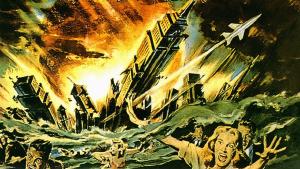Blog
Close Encounters
of the
Stellar Kind
31 December 2014
 Paramount Pictures
Paramount PicturesA star known as HIP 85605 is on a collision course with our solar system.1 Not a collision course as in Armageddon, or When Worlds Collide, but rather on a path to come within 0.04 parsecs of the Sun. That might seem close, but that would make it more than 8,000 times more distant than Earth at its closest approach (8,000 AU). Distant Eris is only 100 AU by comparison. Given that stellar distances are typically measured in light years, and this encounter would be only 50 light days away, that’s remarkably close by astronomical standards. This close encounter won’t occur for another 400,000 years or so. Currently HIP 85605 is about 16 light years away, so we have time to plan for its visit. But it does raise an interesting question as to how such a close encounter could affect our solar system.
One thing we know for sure is it won’t significantly affect planetary orbits. Through computer simulations of the solar system, we find that orbits of the inner planets remain stable over billions of years even with stellar interactions as close as 0.01 parsecs. The most outer bodies such as Pluto and Eris are less stable, but on the whole planetary orbits are stable against all but nearly direct stellar hits.
Where things get less certain is how a stellar encounter would affect bodies in the Oort cloud. Although we know the Oort cloud exists, we aren’t sure about its size. The typical estimate is that the outer Oort cloud is between 20,000 and 50,000 AU from the Sun. In that case HIP 85605 would actually move through the Oort cloud, which would seriously disrupt the icy bodies within it. Some would be flung out of the solar system forever, while others would be thrown toward the inner solar system. This could cause a dramatic increase in the number of comets crossing Earth’s orbit. This uptick would happen over a million-year time scale, but that’s fairly short on geologic scales. What that might mean for life on Earth isn’t entirely clear.
It’s estimated that about 40 stars have made a “close” encounter with the Oort cloud over the last 20 million years, and it has been proposed that cycles of cometary impacts due to such collisions could have led to climate variation and extinction events on Earth. But the evidence for such a connection isn’t very strong. There isn’t a strong correlation between impact events and extinction events, the great dinosaur impact not withstanding.
Given the long history of life on Earth, it isn’t likely that such close stellar encounters have a huge affect on the solar system and life on Earth.
Bailer-Jones, C. A. L. “Close encounters of the stellar kind.” Astronomy & Astrophysics 575 (2015): A35. ↩︎